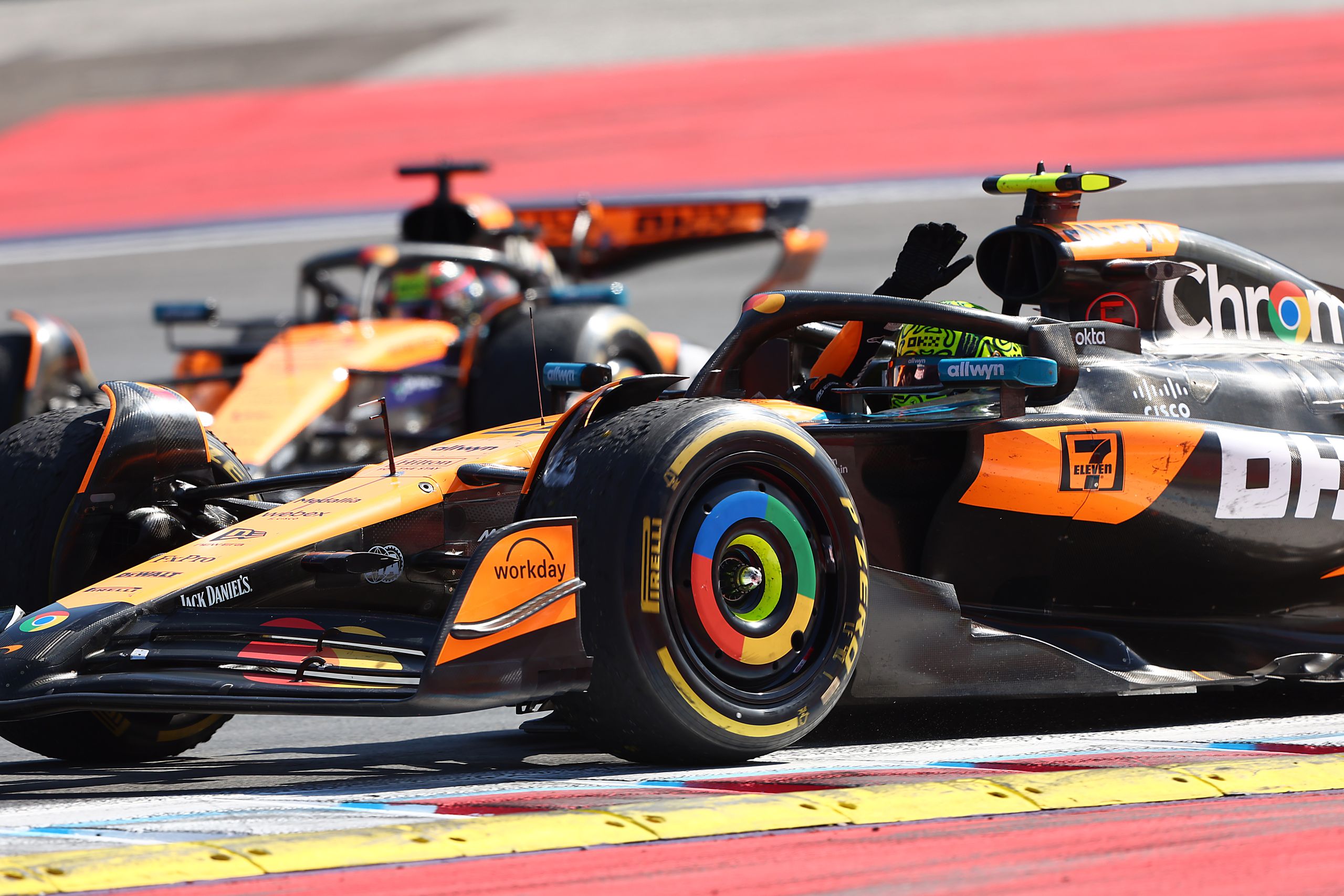What Makes F1 Cars So Powerful?


Turn on your engines and buckle up! We’re about to embark on a thrilling ride into the turbo-charged world of Formula One racing. In this scintillating read, we’ll peel back the carbon fibre cover to reveal the science behind the fiercely powerful F1 cars that dominate the race tracks. From corner-crushing speed, cutting-edge technology to unbeatable performance — we delve deep into what makes these machines the epitome of automotive excellence. Trust us, this is one pit stop you don’t want to miss!
Formula 1 cars achieve their impressive power through a combination of factors. These include advanced engine technology, such as turbocharged 1.6-liter V6 engines, high rotational speeds of up to 15,000 rpm (or even higher), short-stroke designs for increased safety at high speeds, lightweight components, and continuous advancements in metallurgy and design. These factors allow F1 engines to generate immense power and acceleration, making them capable of reaching incredible speeds on the track.
The Powerhouse: F1 Engines
At the heart of every powerful Formula 1 car lies its engine, which serves as the powerhouse propelling these racing machines to incredible speeds. F1 engines are marvels of engineering, designed to deliver high performance, efficiency, and reliability under extreme conditions. These cutting-edge power units have undergone significant changes over the years, reflecting advancements in technology and regulations imposed by the sport’s governing body, the FIA.
The current generation of F1 engines, introduced in 2014, features a 1.6-litre V6 turbocharged hybrid configuration. This represents a remarkable departure from previous iterations, with a strong emphasis on energy recovery systems and improved fuel efficiency. Turbocharging forms a critical component of these engines, enabling enhanced power output by harnessing waste energy from the exhaust gases.
Imagine a turbocharger as a small turbine-driven air compressor attached to the exhaust system. As exhaust gases pass through it, they spin the turbine blades, which in turn drive a compressor wheel that pumps more air into the engine’s intake system. By forcing compressed air into the cylinders at high pressure, turbocharging effectively increases the amount of fuel that can be burned and power produced.
This advancement in engine design brings us to our next crucial element – RPM (Revolutions Per Minute). RPM refers to the number of complete rotations an engine makes within one minute and is instrumental in extracting optimum power output from an F1 engine. These engines boast incredibly high RPM values, often reaching upwards of 15,000 revolutions per minute or more.
Achieving such high RPM figures requires not only precise engineering but also robust materials capable of withstanding intense rotational forces and extreme temperatures generated during operation. Advanced alloys and lightweight components play a key role in ensuring durability and maximizing performance while maintaining structural integrity.
Furthermore, the development of Formula 1 engines is significantly influenced by rules and regulations set by the FIA. These regulations aim to strike a balance between promoting technological innovation and controlling costs while prioritizing safety, reliability, and sustainability.
Now that we have explored the fundamental aspects of F1 engines, let’s dive deeper into the intricacies of turbocharged combustion and RPM to better understand their contributions to the incredible speed and power generated on the track.
Turbocharged Combustion and RPM
Turbocharged combustion is a cornerstone of modern Formula 1 engines, revolutionizing their efficiency and performance. By harnessing exhaust gases that would typically be wasted, turbocharging enables F1 engines to extract more power from a given amount of fuel. The principle behind turbocharging is simple – more air means more fuel can be combusted, resulting in higher power output.
The turbocharger itself consists of two main components: the turbine and the compressor. As exhaust gases exit the engine cylinders, they flow through the turbine, causing it to spin rapidly. This spinning motion in turn drives the compressor wheel, which forces fresh, compressed air into the intake system. With more oxygen available for combustion, F1 engines can burn fuel at a faster rate, generating greater power.
While turbocharging enhances power output by increasing airflow, another crucial factor in maximizing engine performance is RPM. In the context of Formula 1 cars, RPM refers to how fast an engine can rotate its crankshaft within one minute. Higher RPM values translate to more revolutions per minute, enabling the engine to produce substantial amounts of power.
The ability of F1 engines to reach astonishingly high RPM figures is a testament to their engineering prowess and technological advancements. By utilizing lightweight materials and innovative design strategies, these power units can withstand tremendous forces while operating at breakneck speeds. This combination of turbocharged combustion and high RPM allows Formula 1 cars to achieve incredible acceleration and top speeds on the racetrack.
For instance, with an impressive RPM of over 15,000, Formula 1 engines can achieve exceptional power outputs of around 1,000 horsepower or more. This immense power, coupled with the aerodynamic design of the cars and other advanced technologies, enables them to reach mind-boggling speeds of over 330 km/h (205 mph) on straights.
Technology Boosting Performance
In the ever-evolving world of Formula 1, technology plays a pivotal role in pushing the boundaries of performance. Cutting-edge innovations are constantly being implemented to extract every ounce of power from the cars and enhance their capabilities on the track. Let’s take a closer look at some of the technological advancements that contribute to the impressive performance of these F1 machines.
One significant aspect is the engine technology. F1 cars are equipped with highly advanced power units that combine an internal combustion engine with energy recovery systems. These power units employ turbocharging, direct fuel injection, and other sophisticated technologies to maximize efficiency and generate incredible amounts of power. The relentless pursuit of engine performance has led to significant developments in combustion efficiency, resulting in increased horsepower and torque delivery.
Another key technological advancement is data analytics. F1 teams collect vast amounts of data during each race and use sophisticated algorithms and software tools to analyze it in real-time. This allows teams to make informed decisions regarding car setup, tire strategy, fuel consumption, and many other critical factors. Data analytics play a crucial role in optimizing performance by identifying areas for improvement, helping engineers fine-tune setups, and allowing drivers to make strategic decisions on the fly.
Think of data analytics as the pit crew’s secret weapon—a treasure trove of insights that enables them to fine-tune every aspect of the car’s performance during a race.
Moreover, F1 cars make extensive use of advanced sensor technology. Sensors are strategically placed throughout the car to capture vital information regarding temperature, pressure, speed, airflow, and much more. This wealth of data provides teams with valuable insights into how the car is performing in real-time and helps them fine-tune its setup for optimal performance on any given track.
For instance, sensors integrated into the suspension system can provide valuable feedback on how the car responds to bumps and changes in track conditions, allowing engineers to make adjustments that enhance stability and overall handling.
In recent years, hybrid power systems have been introduced in F1 cars, further enhancing their performance. These systems recover and store energy that would otherwise be lost during braking, enabling an additional boost of power during acceleration. The integration of hybrid technology not only increases overall power output but also aids in fuel efficiency, making the cars more sustainable and environmentally friendly.
Now that we’ve explored some of the technological advancements enhancing performance in F1 cars, let’s delve into the importance of high-speed materials and lightweight design.
- As per the regulations from 2014 onwards, Formula One engines can reach up to 15,000 revolutions per minute (RPM), compared to road car engines that operate at less than 6,000 rpm.
- The design of Formula One engines includes a short-stroke structure which complements their high-speed functionality, whilst preventing catastrophic failure.
- Significant developments in metallurgy have made it feasible to use lighter pistons and connecting rods in these engines, thus enhancing their ability to withstand the accelerations needed to achieve high speeds.
High-Speed Materials and Light Weight Design
When it comes to maximizing speed and performance, every gram counts on an F1 car. Achieving lightning-fast lap times requires a meticulous focus on reducing weight while still maintaining structural integrity. This necessitates the use of high-speed materials and groundbreaking lightweight design approaches.
One such material used extensively in F1 is carbon fiber. Carbon fiber composites offer an exceptional strength-to-weight ratio, making them ideal for constructing various components of the car. From the chassis to the bodywork, carbon fiber is employed to minimize weight without compromising structural integrity. This allows for faster acceleration, better maneuverability, and improved overall performance.
To put things into perspective, imagine holding a carbon fiber component from an F1 car in your hand – you would be amazed at its incredibly light weight compared to its stiffness.
Additionally, advanced alloys such as titanium are utilized in critical areas that require both strength and lightness. Titanium’s exceptional properties make it well-suited for components like suspension parts and engine components, contributing to the overall reduction in weight while maintaining durability.
Think about how the choice of materials in an F1 car is like selecting the right ingredients for a gourmet dish – each component must serve a purpose and contribute to the overall masterpiece.
Furthermore, engineers employ innovative lightweight design strategies to optimize every part of the car. This can involve intricate structural geometries, novel manufacturing techniques, and even additive manufacturing (3D printing) for specific components. By analyzing the loads and stresses experienced during racing conditions, designers can create structures that offer optimal strength-to-weight ratios, further enhancing performance on the track.
The combination of lightweight materials and sophisticated design approaches allows F1 cars to achieve remarkable speeds while maintaining stability and safety. This emphasis on weight reduction is a testament to the engineering ingenuity employed in creating these feats of automotive mastery.
Aerodynamics Impact on Speed
In the world of Formula 1, where every millisecond counts, aerodynamics play a pivotal role in determining the speed and performance of the cars. The design and engineering of an F1 car’s aerodynamics has a profound impact on its overall speed and handling. By harnessing the forces of airflow, teams strive to minimize drag and maximize downforce to achieve optimal performance on the track.
Drag, the resistance that acts against the motion of an object through a fluid medium like air, is a significant factor that can hinder speed. F1 teams employ meticulous aerodynamic designs to reduce drag, allowing their cars to slice through the air with minimal resistance. Streamlined bodywork, sleek sidepods, and carefully sculpted wings are all aimed at minimizing drag and optimizing straight-line speed.
On the other hand, downforce is crucial for maintaining stability and grip during high-speed cornering. Downforce is the force pushing the car downward onto the track surface, generated by manipulating airflow around various components of the car. This downward force increases tire adhesion, enabling sharper turns without sacrificing speed. The intricate designs of front wings, rear wings, diffusers, and bargeboards aim to generate optimum levels of downforce for improved cornering performance.
To illustrate this further, imagine driving a road car at high speeds on a windy day. The car tends to feel lighter and less stable due to the lack of downforce compared to an F1 car specifically designed to excel in such conditions. This highlights how aerodynamic principles greatly impact a car’s speed and handling capabilities.
Now that we understand how aerodynamics influence speed in Formula 1 cars let’s explore the fascinating evolution of aerodynamic designs in F1 over the years.
Evolution of Aerodynamic Designs in F1
Aerodynamic innovations have been at the forefront of Formula 1 development for decades. Over the years, F1 teams have continuously pushed the boundaries of technological advancements to gain a competitive edge on the track. The evolution of aerodynamic designs in F1 can be categorized into distinct eras, each presenting unique challenges and breakthroughs.
In the early years, F1 cars featured simplistic designs with minimal aerodynamic components. As the sport grew in popularity and technology progressed, teams began introducing wings to enhance stability and grip. The Lotus 49, introduced in 1967, was one of the first cars to incorporate a rear wing for improved downforce and traction.
Fast forward to the late 1970s, and we witness the advent of ground-effect technology, which revolutionized aerodynamics in F1. Teams such as Lotus and Williams developed intricate underbody designs that utilized shaped side skirts to create a low-pressure zone beneath the car, generating immense amounts of downforce. This era marked a significant leap in performance as cars stuck to the track like never before.
However, safety concerns led to regulations banning ground-effect designs in the mid-1980s. This prompted a shift towards utilizing wings more aggressively to compensate for the lost downforce. Teams started experimenting with intricate front and rear wing configurations in pursuit of optimizing aerodynamic efficiency.
Think of it as a constant battle between engineers striving to squeeze every ounce of performance from their cars within ever-changing regulations—each innovation sparking new ideas and counter-strategies from rival teams, akin to a game of high-speed chess.
With advances in computational fluid dynamics (CFD) and wind tunnel testing technologies, modern-day F1 cars feature complex aerodynamic profiles designed with precision. The intricate front wings with multiple elements and vanes, interconnected with various sections like bargeboards, floor features, and diffusers work harmoniously to generate optimal levels of downforce while minimizing drag.
The science behind aerodynamics in Formula 1 continues to evolve, with teams relentlessly pushing the boundaries of what is possible. In the next section, we will explore how F1 technology transcends the realms of racing and finds its way into road cars.
Translating F1 Technology to Road Cars
Formula 1 (F1) is known for pushing the boundaries of technology and performance, but what does this mean for everyday road cars? The advancements made in F1 often find their way into consumer vehicles, leading to improved safety, efficiency, and overall driving experience. Let’s explore how F1 technology is translated to road cars.
One significant area where F1 technology influences road cars is aerodynamics. In F1, engineers strive to maximize downforce and minimize drag to increase speed and cornering capabilities. These aerodynamic principles are then adapted and applied to road cars, resulting in sleek designs that enhance stability at high speeds and improve fuel efficiency. For example, features such as active spoilers or air curtains on production vehicles can trace their origins back to F1 innovations.
Another aspect that benefits from F1 technology transfer is materials and lightweight construction. In order to increase performance on the track, F1 teams employ advanced materials like carbon fiber composites that offer high strength-to-weight ratios. This same principle extends to road cars, where lightweight materials help improve fuel economy and handling without sacrificing structural integrity or safety.
Take the McLaren P1 hypercar as an example. It utilizes carbon fiber construction borrowed from F1 technology to keep its weight low while maintaining exceptional rigidity. This not only enhances its speed but also improves energy efficiency, making it a prime example of how F1 advancements can be integrated into road cars for remarkable results.
While powertrain technologies have been advancing rapidly in recent years with the rise of electric and hybrid cars, F1 has played a role in shaping these developments as well. Engine technologies like turbocharging and energy recovery systems were initially pioneered in the world of F1 racing before being adapted for everyday use. These technologies have not only improved performance but have also contributed to reducing emissions in road vehicles.
Safety is another area where F1 innovations have had a profound impact on road cars. The rigorous safety standards imposed on F1 cars have led to advancements in areas such as crumple zones, seat belts, and impact-absorbing materials. These innovations eventually make their way into road car designs, enhancing the overall safety of passengers and reducing the severity of injuries in accidents.
Now that we’ve explored how F1 technology is translated to road cars, let’s delve into the influence of F1 innovations on modern automobiles.
Influence of F1 Innovations on Modern Automobiles
F1 serves as a testing ground for cutting-edge automotive technologies that eventually trickle down to road cars, prompting innovation and evolution across the industry. From performance-enhancing features to safety advancements, the influence of F1 innovations can be seen throughout modern automobile design and engineering.
One prominent example is the development of advanced braking systems. In F1, powerful brakes with exceptional heat dissipation are essential for drivers to control their cars at high speeds. These principles have been carried over to road cars, resulting in the development of more efficient braking systems with improved stopping power and reduced brake fade.
To further showcase the influence of F1 on modern automobiles, let’s take a look at some key innovations and their corresponding applications in road cars:
| F1 Innovation | Application in Road Cars |
|---|---|
| Hybrid Powertrains | Electric and hybrid vehicle technology |
| Kinetic Energy Recovery System (KERS) | Regenerative braking for electric vehicles |
| Lightweight Materials | Improved fuel efficiency through weight reduction |
| Advanced Suspension Systems | Enhanced ride comfort and handling |
The emergence of hybrid powertrains in road cars owes much to F1’s push for greater energy efficiency while maintaining performance. The KERS technology used in F1 to recover kinetic energy during deceleration also finds its place in road cars, allowing for regenerative braking and improved overall efficiency.





